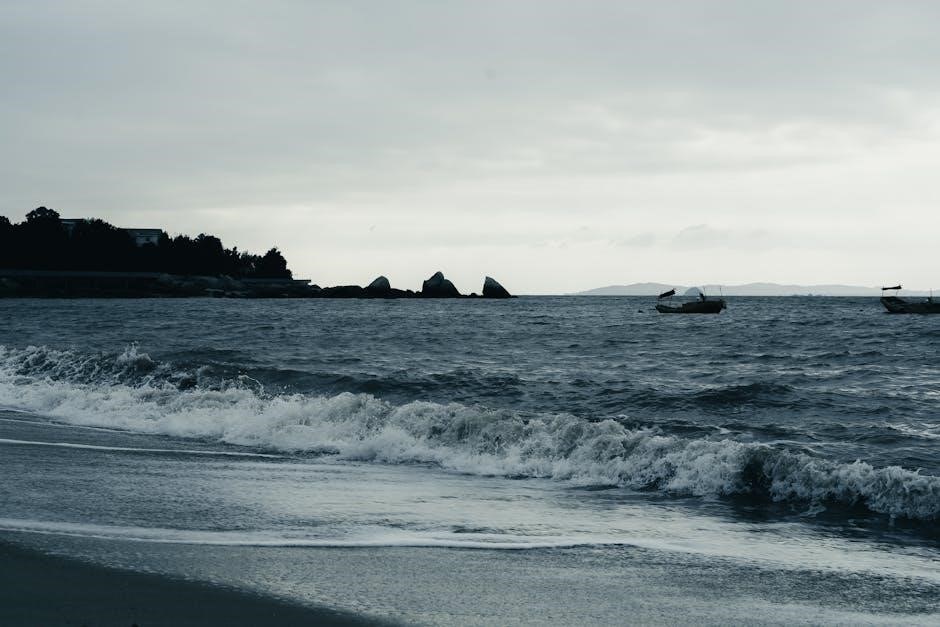Stephen Crane’s “The Open Boat” is a gripping tale of survival, exploring human resilience against nature’s fury. The PDF format ensures easy access to this timeless classic;
1.1 Overview of the Story
“The Open Boat” by Stephen Crane recounts the harrowing tale of four men—two sailors, a cook, and a correspondent—stranded in a small boat after their ship sinks. The story explores their relentless struggle for survival against the merciless sea. Set in the late 19th century, the narrative delves into themes of human resilience, fate, and the indifference of nature. The men face treacherous waves, exhaustion, and the psychological toll of their ordeal, questioning their place in the vast, uncaring universe. Crane’s vivid descriptions and realistic dialogue immerse readers in the men’s desperate fight for life.
1.2 Historical Context
Stephen Crane’s “The Open Boat” was inspired by his real-life experience of surviving a shipwreck in 1897. Crane, a journalist, was aboard the SS Commodore, which sank off the coast of Florida. This harrowing event deeply influenced the story’s themes of survival and nature’s indifference. The late 19th-century setting reflects the era’s maritime risks and human vulnerability. The PDF format of the story preserves Crane’s vivid narrative, allowing readers to engage with his raw, unfiltered depiction of man versus nature. This historical backdrop underscores the universal relevance of the tale, transcending time and format.
1.3 Importance of the PDF Format
The PDF format of The Open Boat offers unparalleled accessibility, allowing readers to engage with the story on various devices. It ensures the text remains unchanged, preserving Crane’s original intent and literary style. The format is ideal for academic and personal use, enabling easy sharing and storage. Additionally, PDFs maintain high-quality formatting, enhancing readability. This convenience makes the story more approachable for modern audiences while safeguarding its integrity for future generations.
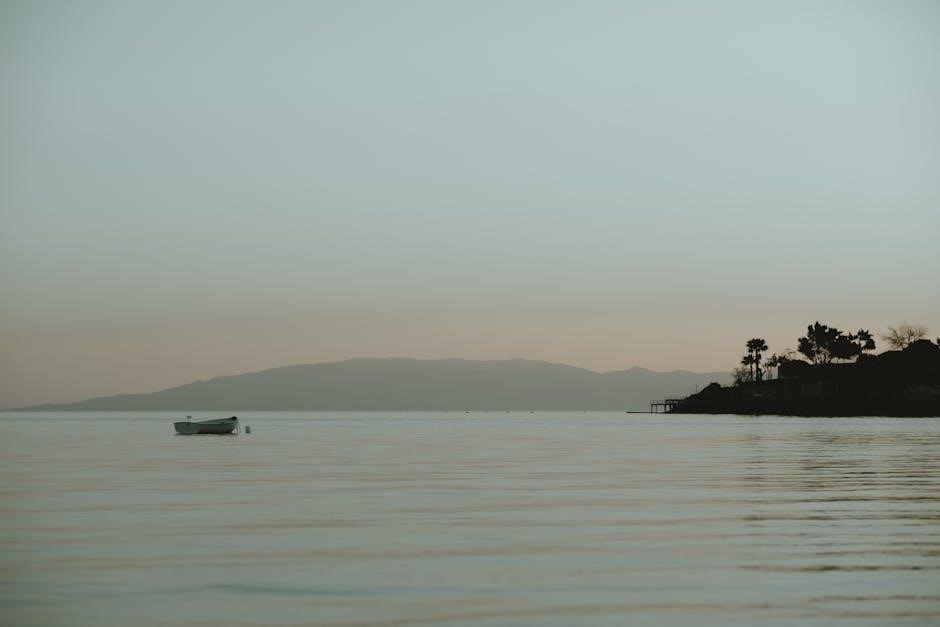
Plot Summary of “The Open Boat”
The story recounts four men’s desperate struggle for survival after a shipwreck, battling the merciless sea, as they cling to life in a small boat, now accessible in PDF format.
2.1 Setting and Background
The story unfolds off the coast of Florida, near the Mosquito Inlet Lighthouse, where a small boat carrying four men struggles to stay afloat amid a fierce storm. The harsh marine environment, with its towering waves and relentless winds, creates a sense of isolation and danger. The setting emphasizes the vastness and indifference of nature, contrasting with the fragile human existence aboard the boat. The background is rooted in Crane’s real-life experience of surviving a shipwreck, adding authenticity to the narrative. The setting establishes the central conflict: man versus nature, a theme that dominates the story.
2.2 Main Characters and Their Roles
The story revolves around four main characters: the Correspondent, the Captain, the Cook, and the Oiler (Billie). The Correspondent, the narrator, reflects on humanity’s struggle against nature. The Captain, though injured, leads with determination and experience. The Cook, less prominent, assists in survival efforts. The Oiler, Billie, emerges as a tragic figure, symbolizing the harsh realities of fate. Each character’s role highlights their resilience, cooperation, and individual strengths, contributing to the story’s exploration of survival and human endurance.
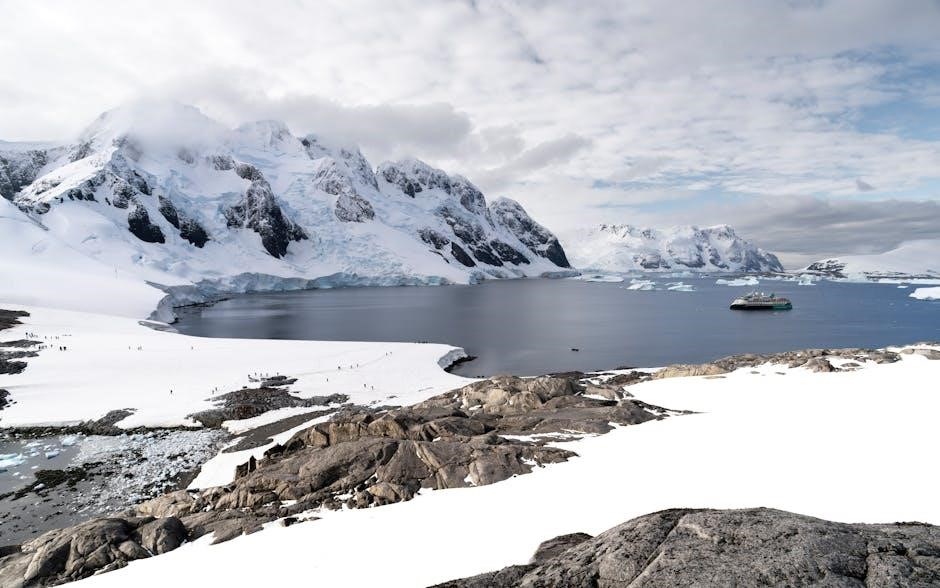
2.3 Key Events and Turning Points
The story begins with four men adrift in a small boat after their ship sinks. The oiler’s death marks a turning point, highlighting the harshness of nature. The men’s relentless struggle to reach shore, despite exhaustion and despair, showcases their will to survive. The sighting of land brings hope, but the correspondent’s near-drowning underscores the unpredictability of fate. The story’s climax lies in their eventual rescue, leaving readers reflecting on the fragility of life and the indifference of nature. These events drive the narrative, emphasizing themes of survival and existential struggle.
Themes in “The Open Boat”
The story explores themes of human resilience, existential questions, and nature’s indifference. The PDF format highlights these themes, making the narrative accessible for deeper reflection and analysis.
3.1 The Struggle Between Man and Nature
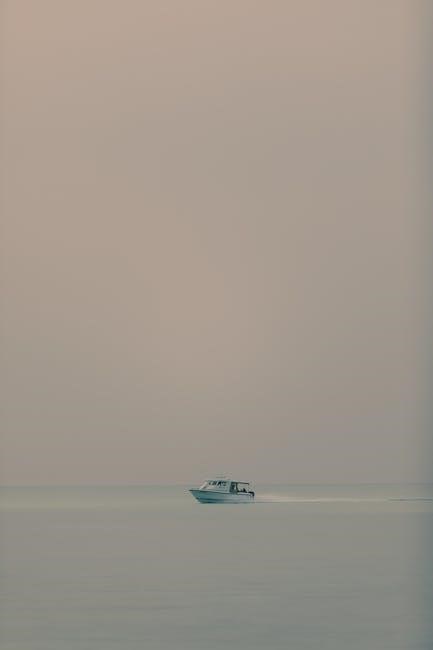
In “The Open Boat,” Stephen Crane vividly portrays the struggle between man and nature through the ordeal of four men battling the relentless sea. The vast, indifferent ocean symbolizes nature’s immense power, while the men’s desperate efforts to survive highlight human resilience. Despite their physical and mental exhaustion, the men attempt to navigate the treacherous waters, illustrating both the futility and courage of human endeavors against nature’s might. The story underscores the existential theme of humanity’s vulnerability in an uncaring universe, emphasizing the delicate balance between survival and the overwhelming forces of nature.
3.2 The Concept of Survival
The concept of survival is central to “The Open Boat,” as the crew battles relentless waves and harsh conditions. Crane vividly portrays the physical and emotional toll of their struggle, emphasizing human resilience. The story highlights the importance of teamwork, resourcefulness, and mental fortitude in the face of overwhelming odds. Through their ordeal, the characters reveal the primal instinct to survive, even when hope seems lost. Crane’s vivid depiction of their fight against nature underscores the universal theme of survival, making the story a profound exploration of human endurance.
3.3 The Role of Fate and Destiny
In “The Open Boat,” fate and destiny are central themes, illustrating the men’s helplessness against nature’s whims. Their survival is not determined by their actions but by chance, emphasizing the randomness of fate. The story portrays fate as indifferent and often cruel, reflecting the harsh realities of existence. Crane uses the characters’ struggles to show that human efforts are insignificant against the vast, uncaring natural world. This underscores the idea that destiny is beyond human control, leaving survival to the mercy of forces beyond their understanding.
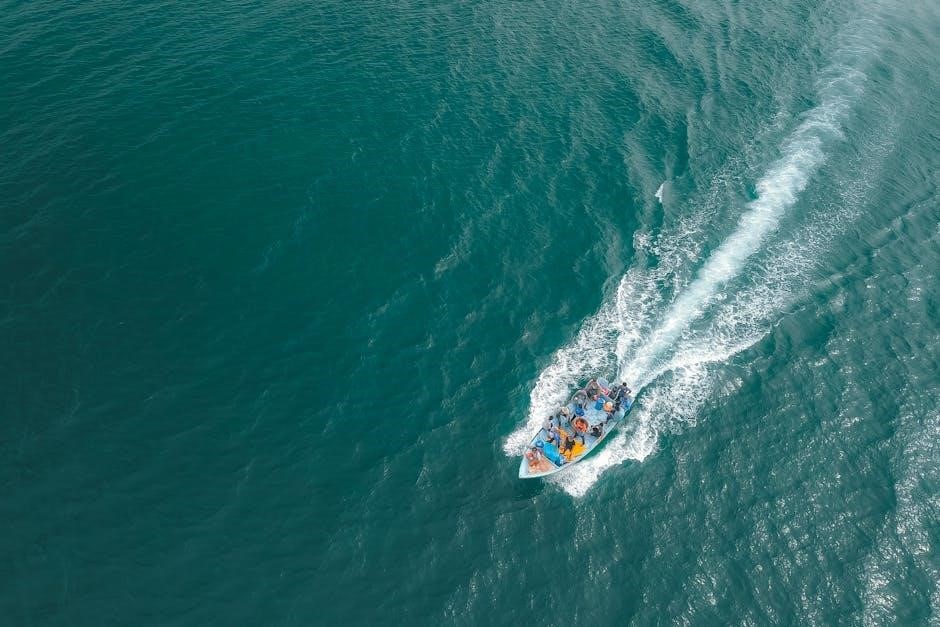
Character Analysis
The story’s characters, diverse in roles and personalities, collectively illustrate the human struggle against nature, each embodying unique traits that drive the narrative’s emotional depth.
4.1 The Oiler (Billie)
The Oiler, Billie, is a central figure in The Open Boat, embodying strength and resilience. His physical prowess and calm demeanor make him a stabilizing force amid chaos. Billie’s interactions with the correspondent reveal a deep sense of camaraderie, as they share moments of vulnerability and mutual respect. Despite his robust nature, Billie’s eventual demise underscores the story’s themes of fate and the unpredictability of life. His character serves as a poignant reminder of human fragility in the face of nature’s indifference, leaving a lasting impact on the narrative’s emotional landscape.
4.2 The Cook
The Cook, though not a central figure, plays a significant role in the crew’s dynamics. His practical nature and focus on survival contrast with the philosophical musings of others. Responsible for rationing food and maintaining morale, the Cook embodies resilience. His actions, though often overlooked, are crucial for the group’s endurance. The Cook’s pragmatism highlights the human ability to adapt in dire circumstances, making him a vital, if understated, character in the narrative.
4.3 The Captain
The Captain in “The Open Boat” is a figure of authority and experience, though he remains largely absent from the boat. His leadership is implied through the crew’s respect and his strategic decisions, such as navigating the treacherous waters. Despite his physical absence, his presence looms over the narrative, symbolizing the broader theme of human struggle against nature. The Captain’s injury and eventual fate underscore the story’s exploration of survival and the unpredictability of life. His character serves as a reminder of the fragility of human control in the face of nature’s indifference;
4.4 The Correspondent
The Correspondent is a central character in “The Open Boat,” serving as both a narrator and a participant in the story. His introspective nature allows readers to connect with his emotional and psychological struggles; Throughout the tale, he grapples with existential questions, reflecting on the meaning of life and the indifference of nature. His observations and musings provide depth to the narrative, making him a relatable figure. The Correspondent’s journey symbolizes the human search for purpose amidst adversity, highlighting themes of survival and the unpredictability of fate. His character underscores the story’s focus on human resilience and introspection.
Symbolism in “The Open Boat”
The open boat symbolizes human existence, while the vast, indifferent sea represents nature’s power. These elements underscore themes of survival and existential struggle.
5.1 The Open Boat as a Symbol of Life
The open boat in Crane’s story serves as a powerful symbol for life itself. It represents the fragile existence of humanity, tossed about by forces beyond control. The boat’s struggle to stay afloat mirrors life’s challenges, where survival depends on resilience and unity. The vessel, though small and vulnerable, embodies the human spirit’s capacity to endure adversity. Its journey symbolizes the collective experience of mankind, navigating unpredictable circumstances while striving to reach safety. Through this symbolism, Crane underscores the universal themes of survival, hope, and the inherent will to persevere against overwhelming odds.
5.2 The Sea as a Symbol of Nature’s Indifference
The sea in “The Open Boat” symbolizes nature’s indifference to human struggles. Crane portrays the ocean as vast, unfeeling, and relentless, with waves crashing impartially against the boat. The characters’ desperate efforts to survive are met with no empathy or response from the sea, emphasizing nature’s detachment. This indifference underscores the theme of humanity’s smallness in the face of natural forces. The sea’s calmness at the end contrasts with the characters’ ordeal, further highlighting its lack of concern for their fate. This symbolism reinforces the idea that nature operates without regard for human existence or emotion.

Literary Devices Used
6.1 Imagery and Descriptive Language
Crane’s vivid imagery portrays the harsh sea and fragile boat, emphasizing human vulnerability.
6.2 Foreshadowing and Irony
Foreshadowing and irony enhance suspense and highlight nature’s indifference, deepening emotional impact.
Stephen Crane’s masterful use of imagery and descriptive language in “The Open Boat” immerses readers in the harsh, unforgiving environment of the sea; Vivid depictions of towering waves, the relentless sun, and the tiny boat create a sense of immediacy and tension. Crane’s descriptions of nature’s power contrast sharply with the fragility of human existence, emphasizing the characters’ vulnerability. His precise language paints a vivid picture of the setting, drawing readers into the struggle for survival. This literary technique not only enhances the story’s emotional impact but also underscores its central themes of nature’s indifference and human resilience.
Crane masterfully employs foreshadowing and irony in “The Open Boat” to heighten tension and underscore the story’s themes. The narrator’s descriptions of the vast, indifferent sea subtly foreshadow the men’s precarious fate. Irony is evident in the contrast between the men’s desperate struggle for survival and the natural world’s apathy. For instance, the correspondent’s philosophical musings about the universe’s indifference are ironically mirrored in the sea’s relentless, uncaring power. These literary devices emphasize the story’s exploration of human vulnerability and the unpredictability of life, leaving readers with a profound sense of existential reflection.
The Historical Context of the Story
Stephen Crane’s “The Open Boat” was inspired by his real-life shipwreck experience in 1897, reflecting themes of survival and nature’s indifference during that era.
7.1 Stephen Crane’s Inspiration
Stephen Crane’s inspiration for The Open Boat stemmed from his real-life experience of surviving a shipwreck in 1897. Crane was a correspondent aboard the SS Commodore, which sank off the coast of Florida. This harrowing ordeal deeply influenced his writing, as he sought to capture the raw emotions and existential struggles of men facing nature’s indifference. The story reflects Crane’s belief in the insignificance of human life against the vast, uncaring universe, a theme central to his philosophy. His personal experience lent authenticity to the narrative, making it a powerful exploration of survival and fate.
7.2 The Real-Life Incident That Inspired the Story
Stephen Crane’s “The Open Boat” was inspired by his real-life survival experience after the SS Commodore sank off Florida’s coast in 1897. Crane, a young journalist, was aboard the ship when it encountered a severe storm and sank. He and three others clung to a small dinghy, enduring harsh conditions and battling the sea for survival. This harrowing incident deeply influenced Crane’s writing, as he explored themes of human resilience, nature’s indifference, and the struggle for survival. The story reflects his firsthand experience, blending realism with philosophical reflections on fate and existence.

Critical Reception and Reviews
Critics praise “The Open Boat” for its vivid imagery and existential themes. The PDF format has enhanced its accessibility, allowing wider readership and deeper analysis of Crane’s masterpiece.
8.1 Initial Reception of the Story
When “The Open Boat” was first published in 1897, it received mixed reviews. Critics praised its raw, realistic portrayal of nature’s indifference and human struggle, but some found its bleakness unsettling. The story’s focus on psychological depth and vivid imagery resonated with readers seeking more mature themes. Despite initial ambiguity, it gradually gained recognition as a masterpiece of Realist literature. The PDF format has made the story accessible to modern readers, ensuring its enduring relevance and allowing new generations to appreciate Crane’s profound exploration of survival and existential themes.
8.2 Modern Interpretations and Analysis
Modern scholars often interpret The Open Boat through lenses of existentialism and environmentalism, emphasizing humanity’s vulnerability against nature. Feminist critics highlight the absence of female characters, underscoring themes of isolation. Postcolonial readings explore the story’s universal appeal, transcending cultural boundaries. The PDF format has made the story accessible for digital analysis, allowing researchers to study Crane’s imagery and symbolism deeply. Educators use the PDF to teach literary devices like foreshadowing and irony. Contemporary readers appreciate the story’s relevance to modern environmental concerns, making it a timeless classic in literary studies.
The Significance of the PDF Format
The PDF format preserves “The Open Boat” in a universally accessible form, ensuring its timeless themes and literary brilliance reach readers effortlessly across devices and generations.
9.1 Accessibility and Convenience
The PDF format of The Open Boat offers unparalleled accessibility and convenience. Readers can easily download and access the story on various devices, including smartphones, tablets, and computers. This portability ensures that the tale of survival and human resilience is readily available anytime, anywhere. The PDF preserves the original formatting, maintaining the author’s intent and enhancing readability. Additionally, features like adjustable font sizes and night mode cater to individual preferences, making the reading experience more comfortable and inclusive for a diverse audience.
9.2 Preservation of the Original Text
The PDF format plays a crucial role in preserving the original text of “The Open Boat.” It maintains the story’s formatting, layout, and integrity, ensuring that Stephen Crane’s work remains unchanged. This format protects the text from accidental edits or alterations, safeguarding the author’s intent and literary style. Additionally, PDFs often include historical context, annotations, and original punctuation, which are essential for scholarly analysis. By preserving the original text, the PDF ensures that future generations can experience Crane’s masterpiece in its purest form, maintaining its literary and historical significance.
Adaptations and Interpretations
“The Open Boat” has inspired various adaptations, including films and stage plays, while its themes are deeply explored in literary critiques and scholarly essays worldwide.
10.1 Film and Stage Adaptations
Despite its literary acclaim, “The Open Boat” has seen limited direct film and stage adaptations. However, its themes and imagery have influenced various maritime dramas. A 1922 silent film adaptation exists, though it is rare. Stage productions often focus on the psychological struggle, using minimalist sets to reflect the vastness of the sea. The story’s introspective nature makes it challenging to translate to visual media, but its universal themes continue to inspire creative interpretations.
These adaptations highlight the enduring relevance of Crane’s exploration of human resilience and nature’s indifference.
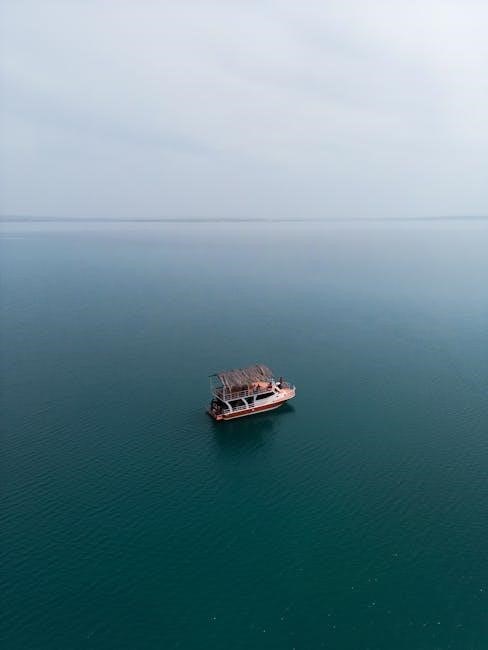
10.2 Literary Criticism and Essays
Over the years, “The Open Boat” has been subject to extensive literary criticism and essays, exploring its themes of naturalism, existentialism, and human struggle. Scholars have analyzed Crane’s use of symbolism, particularly the boat and the sea, to represent life’s fragility and nature’s indifference. Essays often highlight the story’s psychological depth, focusing on the characters’ internal battles and existential reflections. The PDF format has made these critical works widely accessible, allowing readers to delve deeper into the story’s complexities and appreciate its enduring relevance in literary studies.
The Open Boat’s timeless themes of survival and nature’s indifference resonate deeply, ensuring its relevance in the digital age through accessible and enduring PDF formats for future generations.
11.1 Relevance of “The Open Boat” Today
Stephen Crane’s “The Open Boat” remains a powerful exploration of human resilience and nature’s indifference, themes that resonate deeply in today’s world. Its universal appeal lies in its ability to evoke empathy and reflection on survival, fate, and the human condition. The story’s psychological depth and vivid imagery continue to inspire modern readers, offering insights into existential struggles. The PDF format ensures accessibility, making this classic tale readily available for new generations to appreciate its timeless relevance and literary brilliance.
11.2 Final Thoughts on the Story’s Impact
Stephen Crane’s “The Open Boat” leaves a profound impact by exploring human resilience against nature’s indifference. The PDF format ensures the story’s themes and raw emotion are preserved, making it accessible to modern readers. Its vivid imagery and existential themes continue to resonate, offering timeless insights into the human condition. The story’s ability to evoke deep reflection on survival and fate remains a powerful narrative for generations, ensuring its lasting relevance in literature.
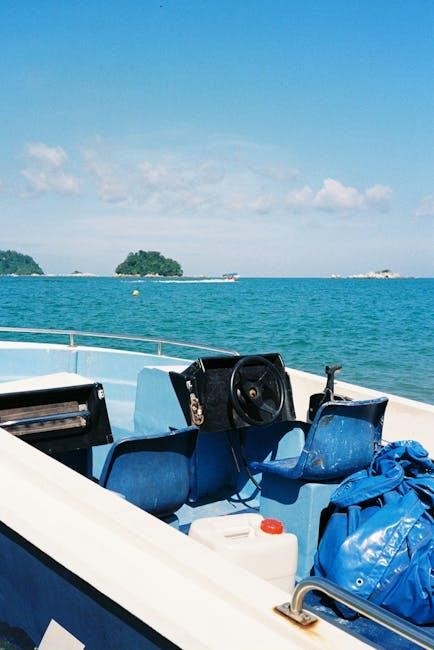
Additional Resources
For further exploration, the open boat PDF offers study guides, critical essays, and online resources to enhance understanding of Crane’s timeless narrative.
12.1 Recommended Reading
For a deeper understanding of “The Open Boat,” explore additional literary works and analyses. Consider reading Stephen Crane’s other works, such as The Red Badge of Courage, to appreciate his style. Essays by critics like Lionel Stevenson and Donald Pizer offer insightful perspectives on Crane’s themes and techniques. Additionally, books on American literary naturalism, such as The Cambridge Companion to Naturalist Literature, provide context for the story’s philosophical underpinnings. These resources enrich your study of “The Open Boat” and its place in literary history.
12.2 Online Resources and Study Guides
Various online resources and study guides are available to deepen understanding of The Open Boat. Websites like Google Scholar and JSTOR offer critical essays and analyses. Educational platforms provide detailed study guides, summaries, and discussion questions. PDF versions of these resources are easily accessible, making it convenient for readers to explore themes, characters, and literary devices. These materials are invaluable for students and enthusiasts seeking to enhance their comprehension of Crane’s masterpiece. They often include historical context, symbolic interpretations, and insights into the author’s writing style.
